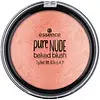What's inside
What's inside
 Key Ingredients
Key Ingredients

 Benefits
Benefits

 Concerns
Concerns

 Ingredients Side-by-side
Ingredients Side-by-side

Isododecane
EmollientWater
Skin ConditioningCyclopentasiloxane
EmollientDimethicone
EmollientSilica
AbrasiveIsobutyl Methacrylate
Butylene Glycol
HumectantEthylhexyl Palmitate
EmollientCetyl PEG/PPG-10/1 Dimethicone
EmulsifyingIsononyl Isononanoate
EmollientDimethicone Crosspolymer
Emulsion StabilisingQuaternium-90 Bentonite
Sorbitan Sesquioleate
EmulsifyingC30-45 Alkyl Dimethicone
Skin ConditioningSodium Chloride
MaskingPhenoxyethanol
PreservativePropylene Carbonate
SolventTocopheryl Acetate
AntioxidantCaprylyl Glycol
EmollientMethicone
EmollientLecithin
EmollientPolyhydroxystearic Acid
EmulsifyingIsopropyl Myristate
EmollientIsostearic Acid
CleansingPolyglyceryl-3 Polyricinoleate
EmulsifyingCI 77891
Cosmetic ColorantIron Oxides
Isododecane, Water, Cyclopentasiloxane, Dimethicone, Silica, Isobutyl Methacrylate, Butylene Glycol, Ethylhexyl Palmitate, Cetyl PEG/PPG-10/1 Dimethicone, Isononyl Isononanoate, Dimethicone Crosspolymer, Quaternium-90 Bentonite, Sorbitan Sesquioleate, C30-45 Alkyl Dimethicone, Sodium Chloride, Phenoxyethanol, Propylene Carbonate, Tocopheryl Acetate, Caprylyl Glycol, Methicone, Lecithin, Polyhydroxystearic Acid, Isopropyl Myristate, Isostearic Acid, Polyglyceryl-3 Polyricinoleate, CI 77891, Iron Oxides
Ingredients Explained
These ingredients are found in both products.
Ingredients higher up in an ingredient list are typically present in a larger amount.
Caprylyl Glycol is a humectant and emollient, meaning it attracts and preserves moisture.
It is a common ingredient in many products, especially those designed to hydrate skin. The primary benefits are retaining moisture, skin softening, and promoting a healthy skin barrier.
Though Caprylyl Glycol is an alcohol derived from fatty acids, it is not the kind that can dry out skin.
This ingredient is also used as a preservative to extend the life of products. It has slight antimicrobial properties.
Learn more about Caprylyl GlycolCi 77891 is a white pigment from Titanium dioxide. It is naturally found in minerals such as rutile and ilmenite.
It's main function is to add a white color to cosmetics. It can also be mixed with other colors to create different shades.
Ci 77891 is commonly found in sunscreens due to its ability to block UV rays.
Learn more about CI 77891